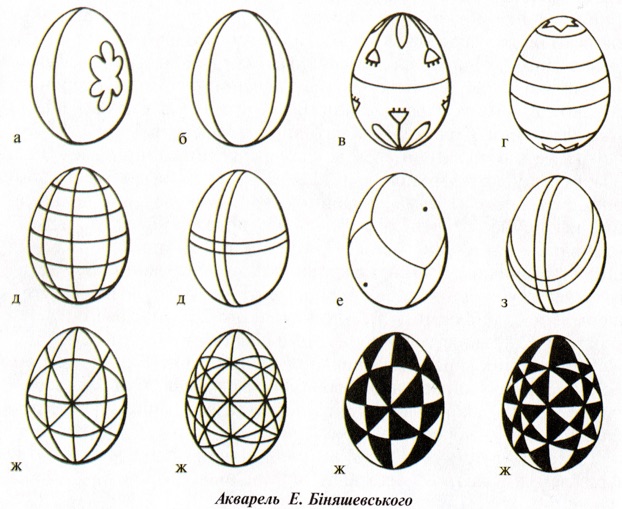Divisions

Traditional pysanka divisions (watercolor by Binyashevsky, 1968)
When analyzing a pysanka’s pattern, the first things which need to be teased out are its axes of symmetry, or how the design elements are lain out on the surface of the egg. What is the scaffolding upon which the design will be constructed, and into which the design motifs will be placed?
There are many different ways of dividing up the surface of an egg, various sorts of symmetry. Some are common, others less so, and even others quite rare. Some are very simple to accomplish, while others involve complex geometry.
There is no commonly accepted nomenclature for these archetypes, nor even a standard set. Erast Binyashevsky, in The Ukrainian Pysanka, deconstructed traditional pysanky into 10 archetypes (see the commonly reproduced drawing above). Others have added to his list; many have shortened it. Vera Manko, in The Ukrainian Folk Pysanka, shows six basic divisions:

The Ukrainian Gift Shop books have also broached the subject of pysanka divisions. Their approach to pysanky has always been more from the artist’s perspective than from the ethnographer’s, and the technical aspects of the art generally take precedence. In the first UGS book, Eggs Beautiful!, Joanna Luciow enumerated twelve divisions, adding to Binyashevsky’s set. In their design book series, however, Natalie Perchyshyn has simplified the divisions into three basic ones upon which almost all patterns can be written.
I will discuss these basic divisions on the next page, and then cover each division in more depth on a page of its own, providing real-life examples (in the form of my pysanky), and instructions on drawing the division if needed.
Back to Main Writing Pysanka page
Back to Main Pysankarstvo page
Back to MAIN Pysanka home page.
Back to Pysanka Index.
Search my site with Google


